*updated 3/2014 with additional resources
If you want to create a prolific writer you need two things- first you need an authentic audience, second you need motivation.
When I was in college my wife and I were dating. For two years we even did the long distance relationship thing. This was pre-internet, pre-cell phone so of course we wrote letters. We still have boxes of those letters.
I was motivated to write, I had an audience. I wrote more during those dating years than I ever did in high school or college. I wanted to write. I needed to write.
Ever since I became a high school teacher I wanted students to engage in real writing. Right away I realized that I was the WORST audience for my students. Even for things like, journal writes, I’d require my students to write down a specific person as their audience. When the internet first hit I had students writing Epinions reviews, emails to authors, letters to the editor, heck one ex-student from Mayfair High School, Gregg Sugimura, wrote online story-lines for a factitious wrestling league and they were awesome. He even named a wrestler in my honor The Montreal Massacre and let me pick my finishing move.
I encouraged my district to buy discussion forum software over eleven years ago even though just a few of us used it. My students love writing to each other- the passion is evident. And then I decided to start blogging earlier this year. I loved it so much I decided to have my students start blogging second semester and so the Re:Framed project was born.
Click here to go check it out
When I first decided to start the blogging project I had to think of a framing mechanism, some way to tie the whole project together. I’ve always been a big fan of Bill Simmons and similar writers who use an area of personal interest to explore the intricacies of another topic. Some examples are:
Bill Simmons, a writer for ESPN, comparing Kobe Bryant to becoming a heel in professional wrestling.
One of my favorite Grantland articles comparing NBA owners to art collectors to explain why NBA owners were being stupid and selfish during the NBA lockout.
So I decided I’d have my students write about what they love. Now this being a school and us having to do schooly things (I wish we could do Schooly-D things- YouTube him at your own risk, I saw him live while I was working the stage for Big Frank from Goldenvoice productions)
that means they need to write about literature or things we learn about in class. So once a week someone from their blog needs to write about what we are learning about in class, but Re:Frame it through the lens of whatever they are interested in. Let me give you a few quick examples.
An exploration of the idea of family in All Quiet in the Western Front and the movie Lilo and Stitch
An exploration of modern day society that asks the question: “Do we live in the novel 1984?”
A blog post on art that started with this quote from class ““It is not what you see that is art. Art is the gap.” -Duchamp
Here is a piece of original art from the previous blog post- they create their own art for their blog- so cool.
The rest of the time they can post words, videos, pictures etc. of anything they are into. Let me give you a few quick examples:
So how did I get them started? Let me show you:
GETTING STARTED:
FIRST: I shared my blog with them. This project is so intense that I don’t think you can truly ask students to blog without blogging yourself. It just won’t work well. How can you teach them something you haven’t done. It’s not like teaching them to write a sentence or even an essay. You are teaching them to create a full brand or identity and to capture a fickle and moving audience. So you need to blog.
I talked to them about why I decided to start blogging, about creating my own identity online instead of allowing others to create it for me. Do I want parents to learn about me though another parent writing something about me on Facebook, or a kid sending up an angry review on Ratemyteacher.com or do I want to show my class to the world on my terms. Young adults and kids get this concept. They live in a world of online comments and changing social definitions. College and jobs will Goggle my students and they can either find something random out of context or they can find an awesome blog. I mean who wouldn’t be proud of something like this?
To view more of Nikki and Amber’s awesome blog click here
But more importantly than creating a perception of who I am, is communicating something that compels me. I love talking and listening to people especially about certain topics: teaching, learning, food, comics, movies, sports etc… my blog allows me to communicate my thoughts to a larger audience then my local community.
SECOND: I talked for a while in class about the need to stay safe online. In order to make this project real we were NOT going to use a student blogging site or platform. We were going to create WordPress.com blogs and release them out into the wild of the internet. I talked about being careful interacting with people in the comment section or being aware of people pumping them for personal information or asking for their emails or other contact information. I will expand on the specifics of student safety in a bit.
THIRD: I showed them my blog and then I showed them a few of my other favorite blogs.
- The artist Austin Kleon’s blog:
- The musician Henry Rollins’ blog
- A blog I visit every day Boing Boing (this was a post about a stiched app for the band TMBG… my students loved looking at this and the artist who created it.)
- I also showed them how people use blogs for their business and that learning to blog and promote your site will come in handy as they start their own business. I even showed them my friend’s real estate blog and we analyzed why he made the content choices that he did.
FOURTH: I explained the concept of Re:Framing. Before I did this I actually created a Re:Framed blog (visit it here) the Re:Framed blog is the main portal of our whole project. All of the blogs are listed there and I re-blog my favorite Re:Framed posts there. When my students Re:Frame something they take something they have learned in class and Frame it through the lens of something they love. We all do this daily when we say something like “oh… creating anticipation in the classroom is like having a beautiful display case of desserts when you walk in a restaurant.” I had to give the students several examples of this, some of them from my blog. It took some students a while to wrap their heads around this idea.
FIFTH: I gave students time in class to pick groups and talk about topics. In fact I gave them about fifteen minutes on one day and then a bit of time the next. Then I walked around the room asking them who was in their group. Groups could not be larger than four students. I was hoping for groups, because following thirty-seven individual blogs for each class was going to be a nightmare. Now the creation of groups raised my first two problems.
Some students wanted to work with students from my other periods. At first I was against this because what would they do when I gave them time in class? We don’t have computers or iPads in class so how would they fill that time? Well it’s worked perfectly. They use paper and their own phone to message the other group their ideas and then the other members read their phone and respond during their class-time.
Some students wanted to work by themselves, and that was fine, but I had a few students who ended up being by themselves through a combination of self-choice and class choice. I wasn’t happy about this and I’ll expand on this later.
After groups were set I had each group tell me their Framing topic. If you look at the list of my sophomore or senior blogs you can see there are a ton of unique topics:
ALT culture (This one makes me feel young again- if you are into Punk music or other 80s ALT stuff)
Cats, beauty, music and the lives of teen girls
I didn’t let them get started until I was sure that each group had a workable topic. This took an entire period of walking around, asking questions, brainstorming etc…
SIXTH: The next day I created a fake blog in each class. I built the blog around a particular student because it makes the kids laugh. I projected WordPress on my overhead projector and went through each step slowly. Showing them how to pick a theme and why some themes were better than others. I showed them how to create a name, how to create a post, how to insert images, how to publish. That night they were supposed to finalize on a name and a theme. I created a link to an editable Google Doc. Each group went into the Google Doc and wrote the name of their blog, a link to their blog, and their names. Then on day three I went through everyone’s link in class, with the overhead projector just to make sure they had a blog and that the name and theme was going to work. A few groups have changed their names and themes as their blog changes and that’s okay.
SEVENTH: I gave them about a week to work on their blog and then made the first Re:Framed post due. Students must post a Re:Framed post once a week. That’s once a week per blog, not per student. Students can write the posts as a group or pair, or they can take turns. I then shared some of the better ones and explained why they worked. After it looked like they got it I set up my safety and organization sheet. Every single student writes online using only their first name or a fake name. They are not allowed to post a picture of a student with a student name next to the picture. So how do I know who is writing the posts? I created a Google Form for each period and I asked the students to input the following information:
- Their name
- The name they use when they write on their blog
- The names of their group members
- The name of their blog
- The url of their blog
- Their login and password information (so if they post something inappropriate I can pull it down quickly)
I’m not a naturally organized person, but this Google spreadsheet is a must for me to keep track of everything.
FINALLY: I cut them loose and they were off. They have been awesome. I’m going to highlight just a few specific student posts:
One group blog posted about our QR activity here
The students who run this blog are the most prolific bloggers I’ve ever seen. They not only blog about music, but they include original stories that have chapters.
This student posted a poem and video on the concept of “Art is Dead.”
Honestly I could spend an hour showing you each blog- don’t forget:
David Theriault’s 2012-2013 Sophomore Honors Blogs
and
Another cool aspect of the project is that I can teach my students about a particular concept and tie it into their blog writing. For example:
I taught them a lesson on the importance of creating a great title. My intro for this lesson was fun. I brought up the analytics for my blog. If you have never seen the analytics for a blog, they are VERY interesting. You can see where the traffic is coming from, which countries follow and view your blog, and more. For this lesson I showed them which of my posts had the most and the least views. The one that had been viewed the least was my post about why I don’t assign formal book reports anymore. The title was:
“Conversations with Dave”
I asked students what they thought the blog post was about. They thought it was me having an internal conversation with myself (my name is David) but instead it was me having a conversation with a former co-worker Dave Penhall. The title was FULL of fail. So I gave them a handout on creating effective titles and then we practiced the skill using various poems with and without titles. (I’ll post a link to the handout when I get back to school next week)
We have been talking in class about promoting our site. One day I taught my students how to create QR Codes. We walking around the campus and posted them everywhere. The codes they created were amazing- very creative. You can see some of the pictures of this activity by reading the March 15th post here.
I even talked with my students about the struggle I have in following all their blogs and so I ended up discovering the RSS reader Feedly and then showed them how I used it to follow their blogs.
A few weeks ago I had each group do a check-in. This was extremely helpful. They got in front of the class and answered these questions as their blog was projected on their pull-down screen in the front of the class.
We actually ended up discovering some solutions to common problems especially how to turn a single long blog into broken up intros with a “jump” to the rest of the blog using the “insert more” button in the WordPress toolbar.
I asked my students the following question in an online discussion forum:
“So why are your blogs doing well? “
Here are a few of their responses
From Selena:
“Honestly, I think one of the main reasons all the blogs are so creative and well done is because we all want to achieve having “the best blog”. I think everyone started making their blog thinking “Oh well I guess I’ll try to make it nice for the grade”, but eventually some of us enjoyed putting the extra effort to make others (followers) love to come back to our blog to keep reading more of our thoughts.
From Karen:
“I think the blogs are doing so well because of a somewhat competitive mentality. Of course we all recognize that this assignment is not really a competition, and every group just wants to get an A on this project. However, every group also wants their blog to be the most liked, most viewed, and most respected by their peers, and especially by Mr. Theriault. Everyone, my own group included, is constantly talking excitedly about how Mr. Theriault liked/reblogged their post. In addition, there may also be competitive spirit within the blog groups themselves. Each person would like to get the credit for being the biggest contributor to the blog, for writing the most liked/commented on post, etc. Therefore, I believe the blogs that are doing well are doing well simply because each group and each person are trying hard to be recognized for being great at blogging, even if they do not want to admit it. “
From Ashley:
“I think the blogs are doing so well because we started to fall in love with blogging. It’s nice to know that some people find your point of view interesting and unique. Also, blogs are an easy way to express ourselves as people. Everyone nowadays wants to be unique and try and stand out. We can post about almost whatever we want, so we only post things that we are passionate and care about. Every post has a little piece of the person within it. People actually want people to read what they blog about, so it doesn’t make sense to write about something that you’re not passionate about.”
From Nick:
“In my opinion, I believe the blogs are doing so well because we are given the opportunity the discuss whatever we want to talk about. We are given a lot of freedom on what we want to write about compared to other classes. As a result, these posts/blogs are of a higher quality since we know what to write about because it’s coming straight from our hearts. Making a blog isn’t a usual thing that English classes do. Now that we’re trying something different, we engage much more of our time to it because it’s interesting to us. It helps us escape from our regular book work from other classes and show the public what we’re really like.”
From Brandon:
“I think the reason why me and campbell’s blog is doing so well is because we aren’t afraid to take risks because why would you really take it safe when this is your child and you have the ability to raise it how you want it…”
From Lucia:
“We have common interests with others. However, we also provide very unique insights! I don’t think anyone’s compared AQWF to TMNT, for example. Blogs are like personal boxes people can peer into. And it’s fun to search around for similarities to yourself. As Missing Piece thinks of it, we find that this search is like finding a missing puzzle piece to your life centered around the things that people like-like art. And it’s our job to help find it! But anyways, it’s fun to make blogs, and snoop around on blogs-you never know what you’re going to find. “
From Janelle:
“I believe our blogs are all working so well because we have the freedom to choose our subject matter. Even though there are minor guidelines, we still have the freedom to relate it to a topic of our personal interest. Typically, when someone has the ability to relate a project to something of his or her personal interest, it makes the process more enjoyable because it is something specific and interesting to that person. It allows each student to add commentary to, read, and share opinions with fellow classmates, and with other people around the globe. I believe that students are motivated by the curiosity of what response they will get when writing a blog post”
WHAT’S NOT WORKING: DON[U]TS
So I have this weird thing in my class. My classes MUST be silent when the bell rings. I don’t want them shushing each other to aheive this silence. I need the silence to last a couple of deep breaths. This is their and my transition to my class. It builds anticipation and centers us. A few days into school I’ll say
“Gosh I love that moment of silence. It even has a smell. It smells like the middle of a donut.”
Now it takes the kids a few moments to realize that a donut has no middle. It’s the baking equivalent of silence. But that silent middle is what makes a donut a donut and not a muffin.
So when I say the DO’s and DON[U]TS of blogging. I don’t mean the don’ts because in my class we don’t make mistakes we take risks, we practice. So the things that aren’t working is what makes this a class a learning lab.
So here are some of my biggest challenges:
I have a senior student who still hasn’t started his blog. He is a student who puts his head down almost immediately upon entering class. I have offered to help him before school, lunch, after-school. I even sat down with him in class got him on my computer and had him sign up for WordPress. I’m still working on this and I’m not happy with him or myself over this.
Getting page views for my students. Some groups are great at this, they understand self-promotion. I actually created a Pinterest site for my students’ blogs. It looks awesome, but I’m not sure how much traffic is being driven there. I actually created a Twitter account for our blog but that has been a big fail (my students don’t use Twitter) and I created an Instagram site for our blog but that was the biggest fail. So promoting the sites and getting page views and comments is still a struggle. A big part of that is creating great and consistent content. I notice that when I take more than a week to post up a new blog post on this site that the page views dwindle to a handful a day.
Some of my students still don’t like using WordPress they want to use Tumblr. I started a class Tumblr at the beginning of the year and then I let it die because I had some sophomore students who had parents who wouldn’t let them use Tumblr. I’m going to have to revisit which blogging platforms I allow and support next year. Perhaps a mix will be allowed. I even had some students who just wanted to code and create their blog all on their own without a hosting platform.
Some of my seniors are struggling to write their blogs due to advanced senioritis they even blogged about it here.
***
Lastly I’d like to thank all of my students. They are the reason the blogging is working so well. They believed in me and they took risks and put their writing out there for the world to see. I’m really proud of them.
BIG UPDATE: For my 10th grade students’ final I had each group present on their blogs and reflect on the project. Here are my thoughts and their thoughts:
PROBLEM: Writing deadline/schedule- At first I made the blog posts due every Tuesday, then something came up and I switched it to Wednesday, then something else came up and it moved to Thursday. You see the problem. This was the NUMBER ONE complaint from my students. Instead of moving the deadline day I need to give individual extensions, if needed. Next year I will pick a day and stick with it: probably Tuesday/Wed/Thursday.
PROBLEM: Pinterest was the WORST way to spend your time promoting your site. The pins LOOK cool, but they do not generate click-throughs. One of my students who “Pins” regularly said that this might be fixed if you put the URL in the comment field since it’s difficult to “click-through” on Pinterest.
PROBLEM: Too much writing- Students complained that they struggled to write 500 words (I laughed because my own blog posts are so long) Not every student complained, but enough. I need to do a better job teaching students how to develop and explore an idea.
PROBLEM: Featured Image- too many students never understood what makes an interesting “featured image” to pull viewers into their blog post, also in some of my groups only one student knew how to upload or create a featured image. I need to make sure that every group member has the power and ability to use WordPress well.
PROBLEM: Failing to teach a big idea- Some weeks were easier to find a RE:Framed concept than other weeks. My students asked that I teach/help them discover at least ONE BIG interesting idea each week to make RE:Framing easier. It was difficult to RE:Frame if they were watching student presentations all week, or I missed several days and had them read quietly with the substitute.
REMINDER: I need to spend at least fifteen minutes once a week showing up a technique or idea when using WordPress. I didn’t realize until they did their final reflections that I failed to show them how to use the pull quote feature and it’s quite effective. I need a regular blogging workshop time.
REMINDER: The power of pictures. Many of my students noted that a visitor came to their blog because they were searching for an image and then clicked on “visit page” on Google Image search. I need to spend more time talking about using pictures powerfully in their blogs.
REMINDER: The event that I created called The Orange County Rising Talent Blogging Awards was based on voting that was done via an online Google Form. There was a HUGE surge of views on all of the blogs that were nominated as students visited those pages to make their decisions. How can I leverage this earlier in the project to get people to visit their blogs?
Can you see the May 29th spike in traffic?
REMINDER: Tagging and focused traffic: some of my more savy students understood the power of tags, but many didn’t. Students who used words like Disney or Kpop in their tags or titles benefited from a dedicated fan base who are interested in the subject, no matter who is writing about it.
REMINDER: When I do the end of the year reflection I will need more than two hours to complete the reflection activity. The final was not long enough to finish.
REMINDER: Top Posts: Students brought up a great point. I need to spend about 10-15 minutes each week highlighting the top posts of the week to get other students into different blogs and to give everyone an idea of what I’m looking for. Additionally, I could use this time to share a non-student blog post that was interesting in content or form.
REMINDER: About/Bio: We need to work on interesting ideas for their about/bio pages
CONCEPT TO THINK ABOUT: Some of my students were really good about creating Pinterest pages, Facebook pages, even Tumblr pages that drove traffic to their blogs. I might need to highlight the best of these and have those students talk about how to do it well with the rest of the class.
This Tumblr was Delicious
CONCEPT TO THINK ABOUT: Some students said that I should require all students to follow each others’ blogs. That following everyone’s blogs would encourage community and comments on their posts. Other students who are a bit more sensitive to their social standings said that they did NOT want to follow everyone’s blogs because deciding to put your name on a list as “following” says that you really like and respect someone’s ideas and that they don’t feel that way about everyone else especially if they think that person is mean or they disagree with their ideas/philosophy in real life. Not sure what I’m going to do about this.
CONCEPT TO THINK ABOUT: I really like the idea of a YouTube channel and an iTunes U channel for the blogs. That means I’m going to need to communicate how to create video and audio content and require it for each blogging group. I’m looking forward to this challenge. I want to make sure that I teach them how to create using only their smart phones or webcams as recording devices so everyone is on a level playing field. They can move beyond those tech solutions, but I want as high a floor as possible.
Overall students still loved the project at the end. Not every student, but more students than would normally love ANY project that was school-based. I still can’t believe that one of my student’s blogs Just Keep Swimming drew over 3,500 views in less than five months and it was a brand new blog. So darn cool.
Click on image for a larger version that’s easy to see
*BIG UPDATE II: My friend Sean Ziebarth wrote a great reply to my concerns you should read his response on his awesome blog.
*BIG UPDATE III: You need to read this blog post to see how you can ELEVATE the celebration of your student’s blogs.
*BIG UPDATE IV: Go to my blog share page for additional resources and links to all of my current students’ blogs.
*BIG UPDATE V: Happening after the #CUE14 Conference

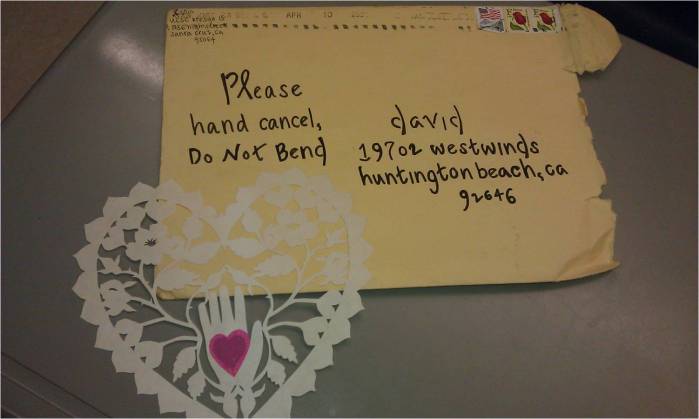




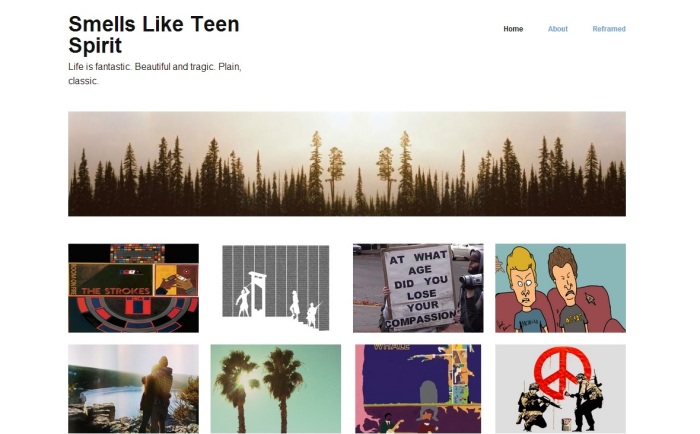
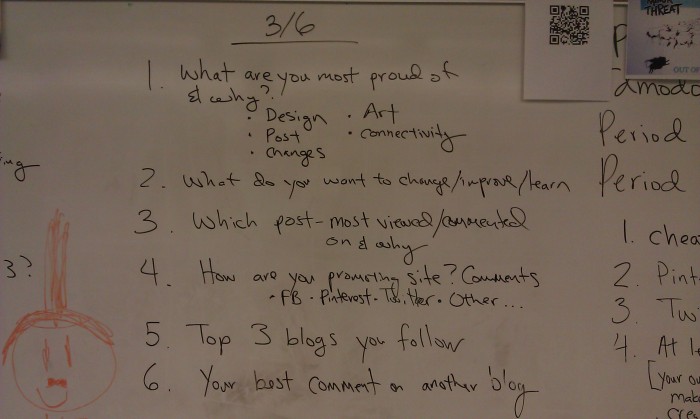

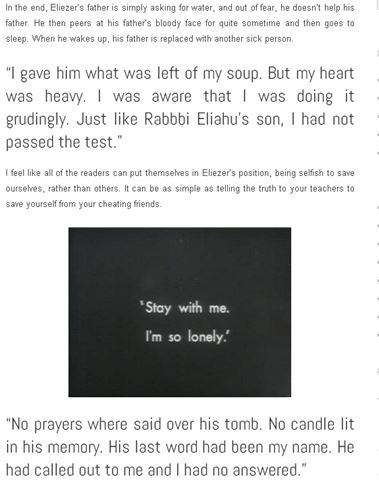
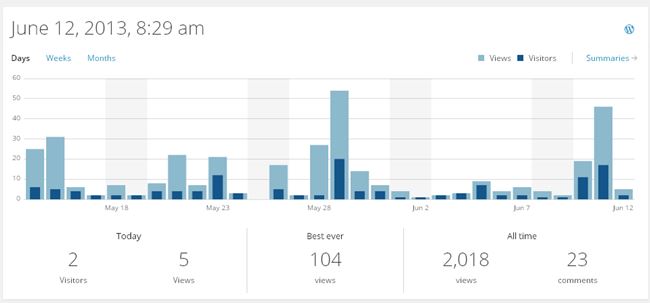
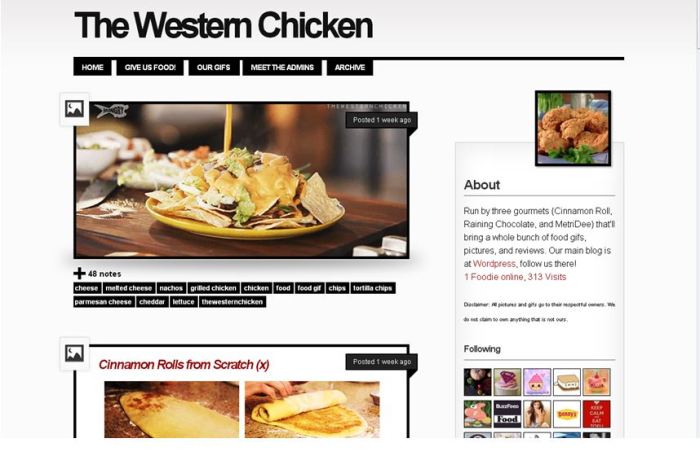
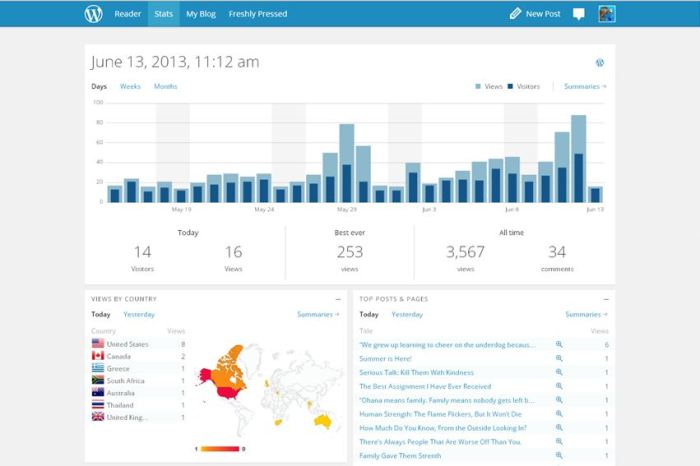
Great post, I have a few short notes/ideas/thoughts.
1) It doesn’t sound like your students are missing a bigger audience. Did I miss that they are wanting more?
2) I appreciate the deliberateness of your teaching blogging. I need to be more deliberate next year when I do that.
3) I really think you hit on something when you said you might allow a mix of platforms next year. I can’t think of any reason why, with the way you set it up, that the students shouldn’t be able to pick their own. It might be worth it to do a pro/con session on each platform too.
4) Why did you wait so long to get them blogging? 🙂
1. Everyone wants a bigger audience. If they like what they are doing.
2. I too fail at this far too often- I’m in love with “winging-it”
3. Agree
4. Because I just started blogging in August of 2012 and didn’t think of it.
Sometimes the value of writing, even on a blog, is through the self-discovery the process gives us. If the students want a bigger audience, they need to learn how to market themselves better. But, not everyone desires a bigger audience.
My suggestion for them to grow an audience is to spend some time conversing with other bloggers. Have them find blogs from other students (although that may be difficult to find high school age blogs) and engage them on their blogs.
Dear David,
Thank you so much for sharing your discovery of blogging with your high school students. I have been teaching blogging with my 4th graders and they have been loving it as well. I have seen teachers on Twitter using the hashtag #comments4kids to gain more readers and comments on blog posts. You may want to try that using your Pinterest board as the link to the posts. Have you researched quad-blogging yet? You could try to set up a quad-blog scenario with three other high school classes. This is a great post! I can’t wait to read your students’ blogs.
Thanks,
Jo-Ann Fox @AppEducationFox
Awesome post! Thank you for taking the time to share the highlights and obstacles of your student blogging project. You have provided an authentic outlet for your students to express–or more likely discover–their creative voice. They produce amazing work that deserves to be publicized. It is obvious how much they respect you as a result. You have every right to be proud.
This week I accomplished my spring break goal by launching a blog site and shared my first posts. I am preparing to have my high school English students blog next year, which means I need to get a feel for the process and plan a strategy for teaching it. I really appreciate the guidance and models you provide. Based on reading some of your posts, I know you won’t mind being considered an Obi-Wan figure!
Brian- I can’t wait to read your blog and see your student blogs next year. Let’s connect our classes next year. Thanks for the awesome reply.
I LOVE what you are doing with/for your students! You’ve certainly given a lot of thought and preparation to the process, and it’s absolutely paying off. This post is a great resource for teachers interested in blogging with their students. I’ll be promoting it on Twitter!
Sharing your own blog, talking about safety and building a positive digital footprint, tipping your hat to other bloggers– what a great foundation. I think that it is important for students to see that their teacher is a writer and a contributor. It validates the process and demonstrates how people learn throughout their lives.
Your reframe idea is fabulous! Connecting learning to the personal takes higher order thinking.
Like life, blogging comes with its own challenges. 🙂
1. My students are quite young, 7 and 8 year olds, but encouraging all to participate is an ongoing process. A few years ago I started a Photo-of-the-day blog. Anyone (including you or any of your students) can contribute a photo. It does not have to be taken on a certain day. Students then write some text to accompany the photo and end with a question to get a conversation going. This has been a good avenue for participation because there are so many choices…there is something for everyone. Plus, some students find that they love photography and that helps bring them in. Here is a link to our 365 project:
http://yollis365project.blogspot.com/
2. I don’t see the harm in letting students use other platforms. I use Blogger with my class blog and photo blog. Throughout the year, I let students earn their own blog and the parents become the administrator of their child’s blog. Blogger is an easy platform to use and I really love bringing parents into the process.
Thanks for the great ideas!
~Linda
I love your 365 photo project. I tried something like that with Instagram but it failed. I’m going to go scour your blog to see how you do it. I might try Tumblr or something else.
Boy, did I ever luck up when I clicked on a twitter link. Having taught high school English for years, it is such a thrill to see a teacher inspire his students while teaching them a life long skills. They may not realize all the other benefits they’re developing under your tutelage … self confidence, discipline, organization, creativity, and the skill of thinking outside the box … but one day they’ll see it. I commend you for caring about them so much, for teaching them to create their own blogs, and for sharing the full experience with the world. Kudos to a fine teacher and human being. You rock!
Thanks Codycowgirl.
i absolutely love this post because….im in it 😀
Great post! Love how you broke the process down into steps as well as included the challenges that arose over the year. I plan on having my students blog next year as I’m a big believer in writing for an authentic audience. I will definitely revisit this post as I prepare to get my students blogging in August. Thanks again for the great ideas and tips!
What an amazing authentic learning experience you’ve created for your students. I thoroughly enjoyed learning about your project and I hope to start something similar in the upcoming school year with my students. I wrote about this project on a blog of my own (I’m still such a novice when it comes to blogging though, forgive me!) http://jagodame.edublogs.org/2013/06/25/reframed-rules/
Keep up the great work and thanks for sharing the “Getting Started” section 🙂
You gave me a lot to think about when teaching blog-writing to my Blended Learning students. Last year I kept our blogs gated within Blackboard, but I think in the fourth quarter I’m going to teach them to move the blogs to another venue. Thanks for the great ideas!
I just found your blog, David. I teach blogging to my college advertising and marketing students. They use the eight-week assignment to develop their personal brand and to learn some basic business writing essentials while reflecting on the industries they’ll be in when they graduate. For me, a communications educator, it’s the ultimate learning experience, partly because the students’ audience is the world (and possibly future employers). This terrifies and motivates students.
Some of my former students have told me their blogs played a role in netting their first professional job upon graduation or even while still in school. Nonetheless, the marking side of the assignment is a killer. I plan to follow your blog to learn about what you do. Thanks for taking the time to share your experiences. I still have lots of work to do on perfecting this assignment and can use all the help I can get.
Reblogged this on Teaching Teacher and commented:
This teacher has hit the nail on the head: in order to become an awesome writer, one needs two things: an “authentic audience” and motivation. I believe the audience creates most of the motivation. What do you think?
I know it’s been a while, but do you still have the “How to Choose a Title” handout? Thanks!
I am discovering blogging with my students this year and it has been awesome but… there is so much more I want to do. Thank you for sharing the wonderful ideas–yours and your students. I can’t wait to start again next year!
As a veteran teacher who is new to blogging in the classroom, I found this step-by-step project very helpful and easy to follow. I look forward to implementing this format into my own classroom! Thank you for the great idea!